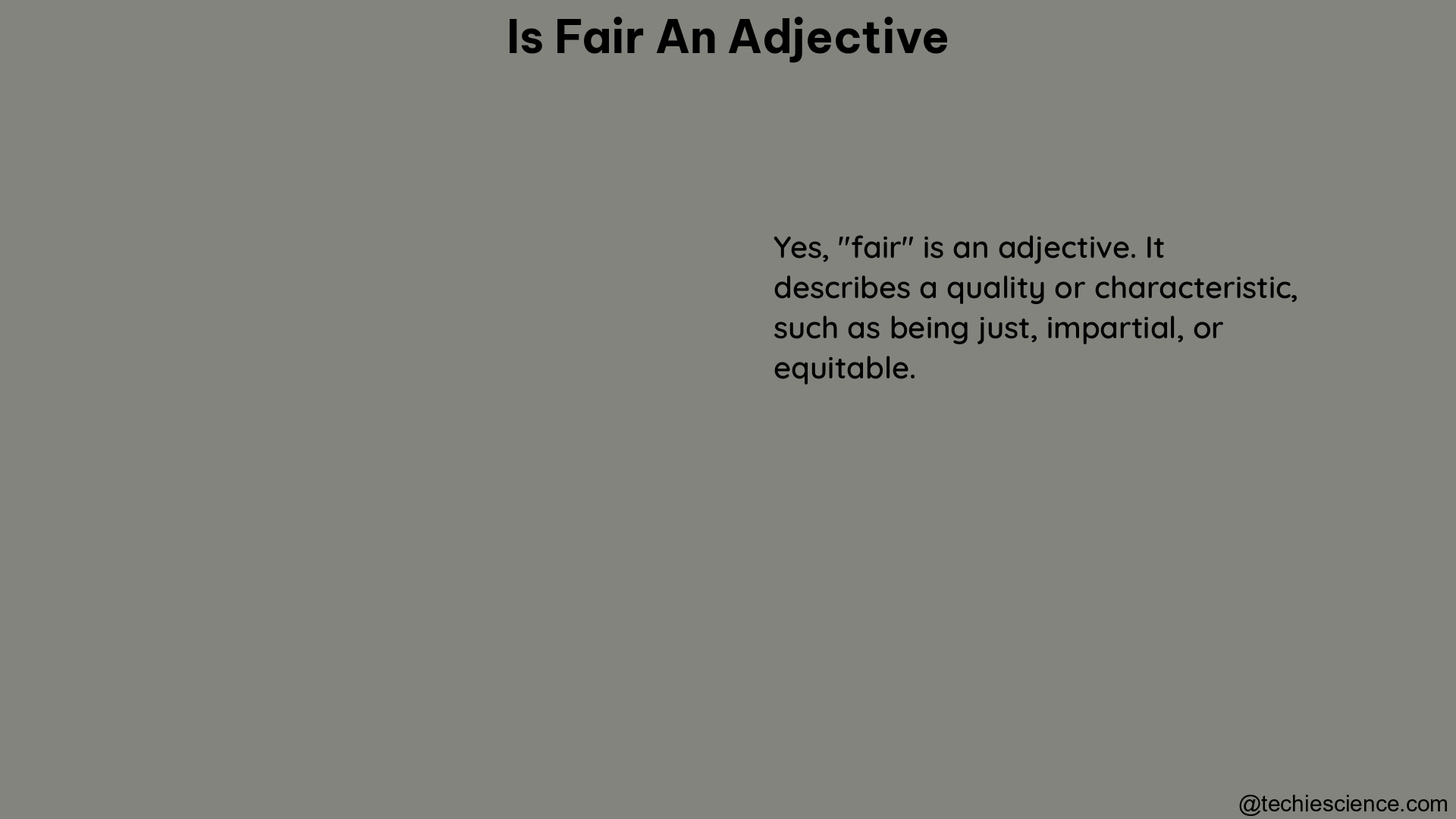Yes, “fair” is an adjective with several distinct meanings and applications in the English language. As an adjective, “fair” can be used to describe a wide range of qualities, from impartiality and reasonableness to physical appearance and even weather conditions. In this comprehensive guide, we will delve into the nuances of “fair” as an adjective, exploring its various usages, grammatical properties, and contextual implications.
Impartial or Unbiased
One of the primary meanings of “fair” as an adjective is to describe something or someone that is impartial, unbiased, or equitable. This usage of “fair” is often seen in legal, political, and social contexts, where fairness and objectivity are highly valued.
Examples:
– The judge tried to be fair in her decision, considering all the evidence presented.
– The referee made a fair call in the game, much to the satisfaction of both teams.
– It’s important to have a fair and balanced approach when discussing sensitive political issues.
Grammatically, the adjective “fair” in this context modifies the nouns “judge,” “referee,” and “approach,” describing their impartial and unbiased nature.
Reasonable or Just

Another common use of “fair” as an adjective is to describe something that is reasonable, just, or equitable. This usage often appears in discussions of fairness, justice, and the appropriate allocation of resources or consequences.
Examples:
– The punishment was fair considering the severity of the crime.
– It’s only fair that we share the workload equally among the team members.
– The company’s new pay scale seems fair, with salaries commensurate with experience and performance.
In these examples, the adjective “fair” modifies the nouns “punishment,” “workload,” and “pay scale,” indicating that they are reasonable, just, and equitable.
Moderate or Average
The adjective “fair” can also be used to describe something that is moderate, average, or not particularly exceptional. This usage often appears in evaluations, assessments, or descriptions of quality or performance.
Examples:
– Her work was only fair, but she showed potential for improvement.
– The weather was fair, not too hot or cold, making it a pleasant day.
– The fair complexion of the model stood out against the vibrant backdrop.
In these cases, “fair” modifies the nouns “work,” “weather,” and “complexion,” indicating that they are of a moderate or average quality or appearance.
Pleasant or Attractive
The adjective “fair” can also be used to describe something that is pleasant, attractive, or aesthetically pleasing. This usage is often found in more poetic or romantic contexts, where “fair” is used to convey a sense of beauty or charm.
Examples:
– The fair maiden was the envy of all who laid eyes upon her.
– The fair landscape was a delight to behold, with its rolling hills and lush greenery.
– The fair-haired child had a captivating smile that drew everyone’s attention.
In these instances, “fair” modifies the nouns “maiden,” “landscape,” and “child,” highlighting their pleasant or attractive qualities.
Light in Color
Another meaning of “fair” as an adjective is to describe something that is light in color, particularly in reference to skin, hair, or complexion.
Examples:
– She has fair skin and hair, a classic example of the “fair-haired” look.
– The fair complexion of the model was a striking contrast to her dark, bold makeup.
– The fair-skinned individual was prone to sunburns, requiring extra sun protection.
In these cases, “fair” modifies the nouns “skin,” “hair,” and “complexion,” indicating that they are light in color.
Idiomatic Expressions
The adjective “fair” is also commonly used in various idiomatic expressions and phrases, where its meaning may extend beyond the specific definitions discussed above.
Examples:
– “All’s fair in love and war” – Suggesting that anything is permissible in matters of love or conflict.
– “Fair enough” – Indicating that a point or argument is reasonable or acceptable.
– “To be fair” – Used to introduce a balanced or impartial perspective on a matter.
In these idiomatic usages, the adjective “fair” contributes to the overall meaning and connotation of the expression, rather than modifying a specific noun.
Grammatical Considerations
As an adjective, “fair” can be used in various grammatical constructions to modify nouns and pronouns. Some key grammatical properties of “fair” as an adjective include:
-
Attributive Adjective: “Fair” can be used as an attributive adjective, directly preceding the noun it modifies, as in “a fair decision” or “the fair maiden.”
-
Predicative Adjective: “Fair” can also be used as a predicative adjective, appearing after the noun it modifies, as in “The weather was fair” or “The punishment seemed fair.”
-
Comparative and Superlative Forms: Like many adjectives, “fair” can be used in comparative and superlative forms, such as “fairer” and “fairest,” to indicate degrees of comparison.
-
Adverbial Use: In some cases, “fair” can be used as an adverb to modify a verb or another adjective, as in “She played the game fairly” or “The weather was fairly pleasant.”
It’s important to note that the specific grammatical usage of “fair” as an adjective will depend on the context and the intended meaning being conveyed.
Conclusion
In summary, “fair” is a versatile adjective in the English language, with a range of meanings and applications. From describing impartiality and reasonableness to conveying physical attributes and idiomatic expressions, the adjective “fair” plays a crucial role in our language, allowing us to communicate nuanced and precise ideas. By understanding the various usages and grammatical properties of “fair” as an adjective, you can enhance your command of the English language and communicate more effectively in a wide range of contexts.
References:
- Vocabulary.com – The Meaning of “Fair”
- Merriam-Webster – Definition of “Fair”
- Oxford Learners Dictionaries – Definition of “Fair”
- Cambridge English Dictionary – Definition of “Fair”

Hi…..I’m a graduate with a Bachelor’s degree in English Literature. I wish to do a Masters in the same field someday and continue my career in Academia.
Let’s connect through LinkedIn: